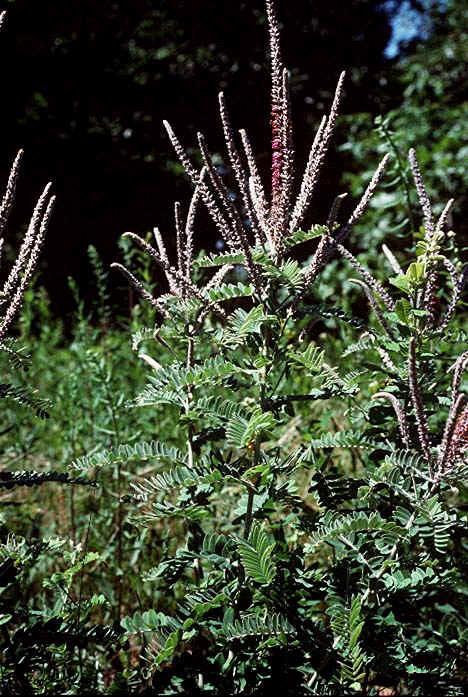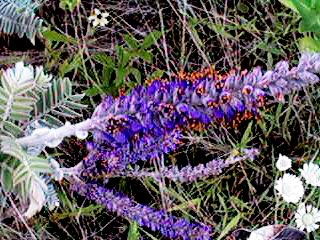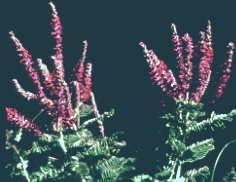
Lead Plant: Amorpha canescens
Charles Umbanhowar Jr., Spring 1998, Minnesota Plant Press 17(3)
Lead plant ( Amorpha canescens Pursh ) is one of the few native shrubs on the prairies of Minnesota. The common name may refer to the grayish color of the leaves or perhaps to an old belief that the plant was an indicator of lead ore deposits. Amorpha comes from the Greek amorphos meaning 'without shape or deformed" in reference to the small (-1/4 inch) flower which is reduced to a single petal; and canescens is Latin meaning 'gray-hairy". Lead plant is widely distributed throughout the prairies of Minnesota especially in mesic or dry areas. Individuals grow 1 to 2 feet tall. They are shrubby, meaning they have woody stems and their buds are above the ground, but they can bud from ground level if plants are burned or grazed. A member of the bean family, the leaves are compound, like most legumes, are 2 to 4 inches long, and are composed of - 25 pairs of grayish leaflets along a single axis (rachis). Flowers are born on several terminal spikes. An individual spike may contain 50 to 100 flowers. The massing of so many small flowers and the contrast of the single purple petal and yellow stamens of each flower can only be appreciated at close range but it is one of the great joys of viewing this plant. When pollinated each flower produces a single seed, borne in a small, gray hairy pod. Seeds require both a cold period and heat to germinate. Heat can be provided by pouring boiling water over the seeds and then allowing the water to cool.
As a legume, lead plant is a host to nitrogen-fixing bacteria in its roots. The bacteria provide the plant with nitrogen in exchange for sugars that the plant produces through photosynthesis. These bacteria are available as inoculum from most native-seed suppliers. Intensive grazing will reduce the abundance of lead plant, and it does not tolerate cultivation. Periodic burning reduces plant size but increases plant number-a pattern found for many prairie legumes. I often use the presence of large lead plants or old, dead stems as a sign that an area has not been burned in the last several years.
Lead plant is one of 15 species of Amorpha present in the United States, and one of 3 species in Minnesota. False indigo (Amorpha fruticosa) grows 5 to 6 feet tall, and the leaflets are larger and seem to be less hairy than those of lead plant. Dwarf wild indigo (Amorpha nana) is found in the western, dry prairies of Minnesota. It is more diminutive in stature (-l foot tall), and the leaflets are greener and more rounded.
Lead plant and the other Amorphas have been used medicinally by Native Americans who called it "buffalo bellow plant' because it bloomed coincident with the rutting of bison. Drunk as a tea or smoked, the plant was used to treat ailments as varied as pinworms, eczema, and rheumatism.

Leadplant
Family: Legume
Size: 3 inch cluster
Date: Early June

Amorpha canescens)
Leadplant (Amorpha canescens)
The beautiful dark purple spikes of leadplant should be appearing now on the North Dakota prairies. Leadplant is primarily a plains dweller but also occurs in sandy open woods as far east as Michigan and Indiana.
This plant may reach forty inches in height but usually is about a foot and a half tall in our area. The plant gets its colloquial name from the gray appearance caused by fine hairs which cover the leaves stems and unopened flowers. Flowering spikes are crowded at the top of the stems. Each spike produces nearly a hundred tiny flowers. Leaves are composed of about twenty pairs of oval leaflets. The thick taproot of this perennial plant penetrates deep underground. At maturity the seedpods (legumes) are about three-sixteenths of an inch long.
Leadplant is fairly common on most native prairies in eastern North Dakota. The plant seems to reach best development on east- and southfacing slopes. Leadplant is good livestock forage as indicated by a two to tenfold reduction in coverage of the plant on heavily grazed pastures as compared to those moderately or lightly grazed. When long-idle native prairie dominated by introduced grasses is burned in the spring, leadplant and other native plants usually show a remarkable recovery.
Leadplant is a member of the bean family (Fabaceae) which contains hundreds of economically important plants. Fab means "bean" in Latin. The generic name Amorpha stems from the Greek amorphos, "deformed," in reference to the absence of four of the five petals normally found on
![]()
 Wildflower
Seed For Sale
Wildflower
Seed For Sale